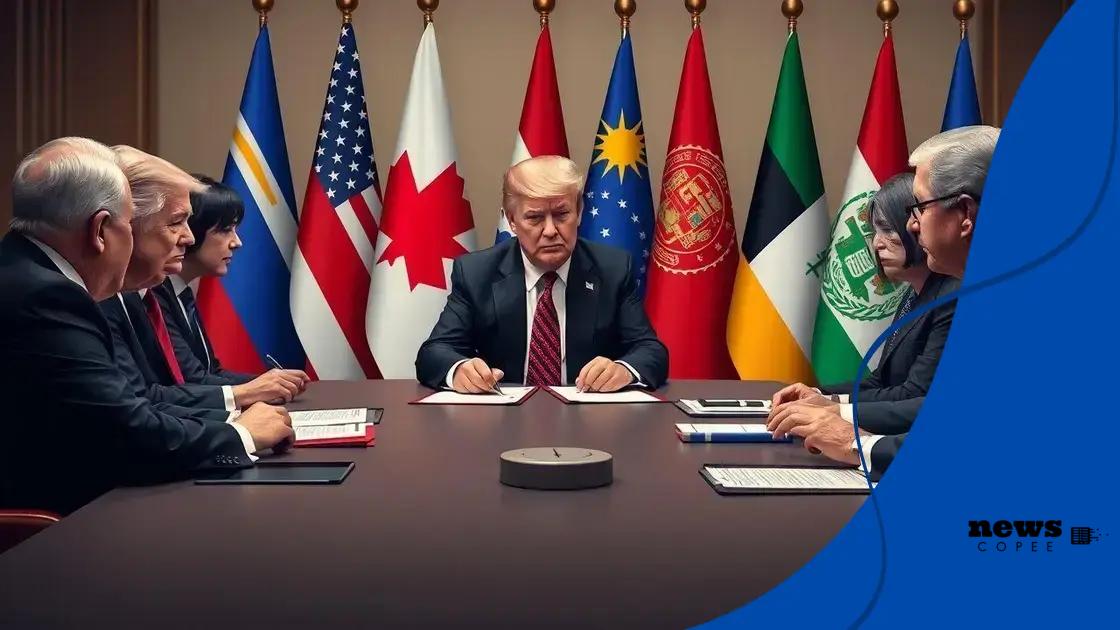Policy direction under Trump shows change in major areas

The policy direction under Trump shows change through significant economic reforms, stricter immigration laws, and a polarized public perception, influencing social issues and foreign relations in the United States.
Policy direction under Trump shows change in various areas that have shaped the current political landscape. Ever wondered how these shifts affect your day-to-day life? Let’s dive into the details.
Economic policies implemented during Trump’s tenure
During Trump’s presidency, economic policies underwent significant changes. These policies, often characterized by tax cuts and deregulation, aimed to stimulate growth and create jobs. Understanding these measures is crucial for grasping their long-lasting effects.
Tax Cuts and Jobs Act
One of the most notable legislative achievements was the Tax Cuts and Jobs Act of 2017. This act reduced the corporate tax rate significantly, from 35% to 21%. The aim was to encourage businesses to invest more in the U.S. economy.
As a result, many companies reported increased profits and higher stock prices. However, critics argue that this primarily benefited the wealthy and increased the national debt.
Deregulation Efforts
Another critical aspect of Trump’s economic strategy was deregulation. The administration rolled back numerous regulations across various industries, claiming that these changes would boost economic activity.
- Environmental regulations were relaxed to promote energy production.
- Financial regulations were eased, encouraging lending and investment.
- Healthcare and labor regulations saw significant revisions, impacting workers’ rights and benefits.
These efforts aimed to provide businesses with more freedom, allowing them to thrive without as much governmental oversight.
During this period, the economy saw low unemployment rates, rising wages, and increased consumer confidence. However, some experts caution that deregulation may have long-term consequences for public health and safety.
In summary, Trump’s economic policies focused on tax cuts and deregulation, attempting to foster a more business-friendly environment. While there were positive short-term effects, the broader implications remain a subject of debate.
Changes in immigration policy and their effects
The changes in immigration policy during Trump’s presidency significantly impacted both the lives of immigrants and the U.S. economy. These shifts were designed to prioritize national security and reduce illegal immigration.
Border Security Measures
One of the key changes was the emphasis on border security. The Trump administration implemented stricter measures to control immigration. This included building barriers along the U.S.-Mexico border and increasing the number of border patrol agents.
These efforts aimed to deter illegal crossings. However, critics argue that these measures have led to humanitarian crises at the border.
Change in Visa Policies
Another significant area of focus was the adjustment of visa policies. The administration sought to limit the number of visas issued for certain categories, particularly for skilled workers. This shift intended to prioritize American workers in the job market.
- Reduction in H-1B visas for skilled immigrants.
- Increased scrutiny of visa applications.
- Limitations on family reunification policies.
While these policies aimed to protect American jobs, many businesses reported difficulties in filling skilled positions, leading to concerns about economic growth.
The overall effect of these changes has been a more polarized discussion around immigration in the U.S. Supporters argue for the need for strict measures to keep the nation secure. In contrast, opponents highlight the importance of immigrants in contributing to the economy and local communities.
As the situation continues to evolve, it’s clear that the changes in immigration policy under Trump will have long-lasting implications for the nation, shaping not only the lives of millions of individuals but also the fabric of American society.
Trump’s approach to foreign relations and trade

Trump’s approach to foreign relations and trade marked a significant shift in U.S. policy. His tactics focused on America First principles aimed at prioritizing national interests, which reshaped key alliances and economic agreements.
Trade Agreements and Tariffs
One of the most notable changes was Trump’s renegotiation of trade agreements. The administration withdrew from the Trans-Pacific Partnership, believing it hurt American workers. Instead, Trump pushed for bilateral agreements that favored the U.S.
He also imposed tariffs on several countries, notably China, to combat what he termed unfair trade practices. These tariffs aimed to protect American companies and jobs from foreign competition.
- Increased tariffs on steel and aluminum imports.
- Negotiation of the United States-Mexico-Canada Agreement (USMCA).
- Pressure on NATO allies to increase defense spending.
While supporters argued these actions protected U.S. economic interests, critics expressed concerns about potential trade wars and higher costs for consumers.
Diplomatic Relations
On the diplomatic front, Trump’s style was often described as unconventional. He emphasized direct communication with leaders, including North Korea’s Kim Jong-un. This approach led to historic meetings aimed at reducing tensions.
Trump also criticized long-standing alliances, challenging NATO members to increase military spending while questioning the value of international agreements like the Iran nuclear deal.
These actions created a more unpredictable environment in global politics. Some viewed it as a necessary break from tradition, while others feared it undermined decades of diplomatic efforts.
Overall, Trump’s approach to foreign relations and trade reshaped America’s role on the world stage, leaving lasting effects on international partnerships and economic policies.
Impact of Trump’s domestic policy on social issues
The impact of Trump’s domestic policy on social issues has been profound, affecting various aspects of American life. His administration’s actions stirred significant debate and reactions, particularly in areas like health care, education, and civil rights.
Healthcare Policy Changes
One major social issue during Trump’s presidency was healthcare. The administration sought to repeal the Affordable Care Act (ACA), aiming to replace it with a system that prioritized free market solutions. This effort led to uncertainty for many Americans relying on the ACA for coverage.
While some argued this would lower costs, critics pointed out that it could leave millions without access to essential services.
Education Reform Initiatives
In education, Trump’s policies focused on increasing school choice. The push for charter schools and voucher systems aimed to provide families with alternatives to public schools. Proponents believed this would enhance education quality.
- Increased funding for charter schools.
- Promotion of private school vouchers.
- Restrictions on federal funding for schools promoting certain curricula.
However, opponents argued that these changes could divert funds from public schools and further widen educational disparities.
Additionally, Trump’s stance on civil rights sparked increased activism. His administration faced backlash for policies perceived as discriminatory, particularly concerning immigration and LGBTQ+ rights. Social movements like Black Lives Matter gained momentum, highlighting systemic issues that persisted under his term.
Amid these challenges, the administration’s decisions often led to polarized responses. Supporters viewed his policies as necessary reforms, while detractors saw them as harmful to social progress.
The impact of Trump’s domestic policy on social issues continues to resonate, shaping discussions in American society and influencing future policy directions.
Public perception of Trump’s policy changes
The public perception of Trump’s policy changes has been highly polarized, reflecting deep divisions in American society. Many individuals responded passionately to the shifts in domestic and foreign policies, leading to intense debates.
Support from His Base
Among Trump’s supporters, his policies were often seen as a refreshing change. Many praised his focus on economic growth and job creation. Initiatives like tax cuts and deregulation received positive feedback for potentially boosting the economy.
Supporters felt that Trump’s tough stance on immigration was necessary to protect American jobs and national security. They appreciated his direct communication style and bold actions in reshaping trade deals.
- Increased optimism about job opportunities.
- Support for reducing government regulation.
- Approval for tough immigration policies.
Criticism and Opposing Views
Conversely, critics argued that many of Trump’s policies negatively impacted vulnerable populations. For instance, changes in healthcare and immigration laws raised concerns about access to essential services for millions.
Social justice movements gained momentum in response to perceived discrimination and inequality stemming from his policies. Many people felt marginalized by decisions on issues like racial equality and LGBTQ+ rights.
The handling of international relations also faced scrutiny. Critics believed that Trump’s foreign policy led to increased tensions with traditional allies and diminished the U.S.’s standing on the world stage.
Public opinion polls throughout his presidency indicated fluctuating approval ratings, highlighting substantial disagreements over his approach. These surveys often reflected a divided nation where many felt strongly, either in support of or opposition to his policies.
The public perception of Trump’s policy changes continues to influence political discourse, shaping future elections and party alignments.
FAQ – Questions Frequently Asked About Trump’s Policies
What were some key economic policies implemented during Trump’s presidency?
Key economic policies included tax cuts, deregulation, and an emphasis on job creation through the Tax Cuts and Jobs Act.
How did Trump’s immigration policy change under his administration?
Trump’s immigration policy focused on increasing border security, reducing visas for immigrants, and implementing stricter regulations on illegal immigration.
What was the public’s perception of Trump’s foreign relations strategy?
Public perception was polarized; supporters approved of his direct approach, while critics expressed concern about strained alliances and increased tensions.
What impact did Trump’s policies have on social issues in America?
Trump’s policies led to significant debate around healthcare, education reforms, and civil rights, impacting various social dynamics across the nation.
